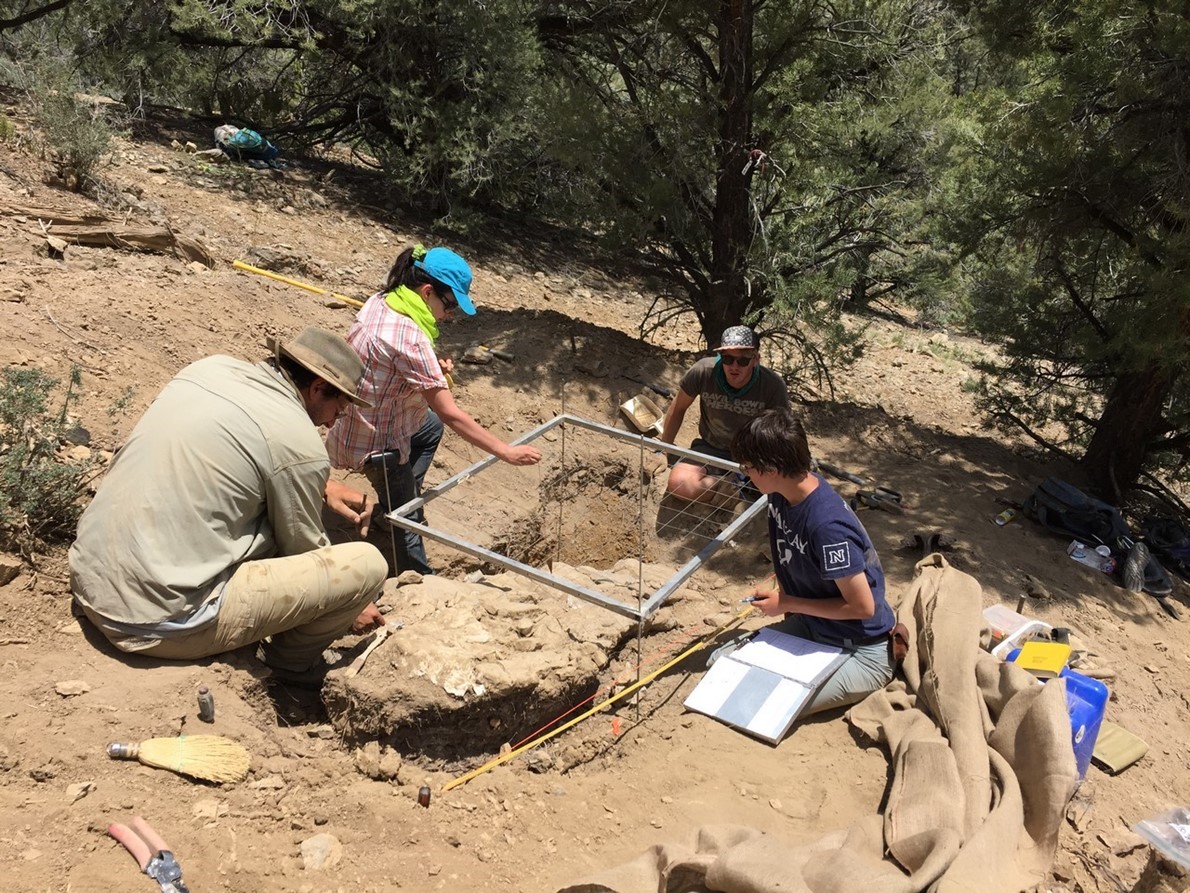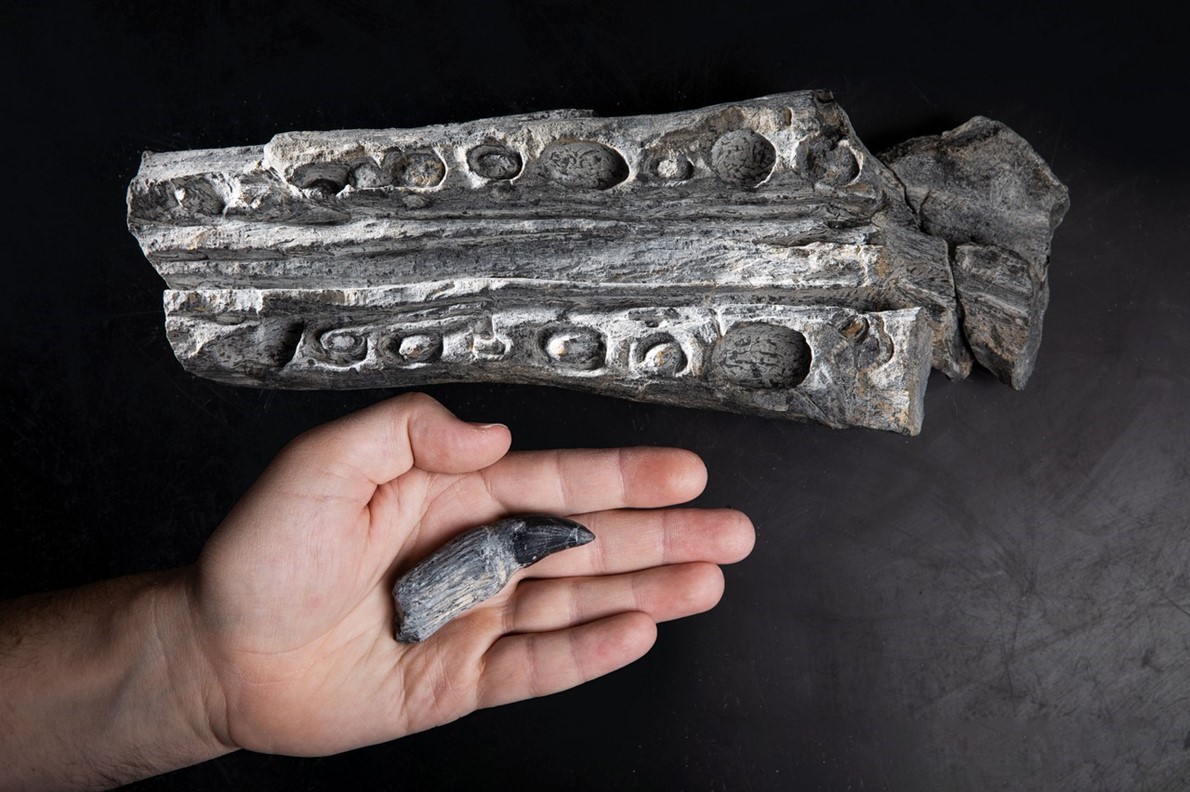The mystery
has haunted paleontologists for decades: What explains a fossilized mass death
event in the rocks of the West Union Canyon in Nevada? Even more
mysterious:
Why are the victims all large predatory marine reptiles called ichthyosaurs
that swam the seas while
dinosaurs walked the earth?
اضافة اعلان
One research team says
in a paper published last week in the journal Current Biology that this enigma
in stone has finally been solved.
 Scientists with a
newly discovered Shonisauruspopularis fossil skeleton at Berlin-Ichthyosaur
State Park.
Scientists with a
newly discovered Shonisauruspopularis fossil skeleton at Berlin-Ichthyosaur
State Park.
The reptilian
graveyard was once a habitat for whale-size ichthyosaur Shonisauruspopularis.
Some 230 million years ago, it was “this shallow tropical ocean”, said
Randal lIrmis, a paleontologist at the Natural History Museum of Utah and an author of
the study. “Now we’re in the middle of the Great Basin in the high desert, at
the foothills of the Shoshone Mountains.”
The canyon’s most
famous cluster of corpses, a grouping of at least
seven skeletons known as
Quarry 2, can be visited at Berlin-Ichthyosaur State Park. Scientists have
speculated about the ichthyosaurs of Quarry 2 since they were first excavated
in the 1950s by Charles Camp, a University of California, Berkeley,
paleontologist.
This was not just one case of mass death, but many, and all of the victims seemed to be adult ichthyosaurs.
But Irmis and
colleagues discovered in 2014 that other ghastly groupings had occurred in the
canyon at different points in history, spanning hundreds of thousands of years.
This was not just one case of mass death, but many, and all of the victims
seemed to be adult ichthyosaurs.
The researchers used
various techniques, including 3D scans that digitally reconstructed the
fossils, to methodically eliminate
hypotheses for how the titanic animals met
their end. The first suspect: mass stranding events, like those seen in whales
today. “It doesn’t match the sedimentology that we find,” said Nicholas
Pyenson, a paleontologist at the Smithsonian National Museum of Natural History
in Washington, DC, and an author of the study. “There’s no beach deposits,
there’s no tidal flats.” Instead, he said, the rocks suggest that the area
would have been
submerged in more than 300 feet of water.
 A complete tooth and
partial jaws of Shonisaurus popularis.
A complete tooth and
partial jaws of Shonisaurus popularis.
To rule out poisoning
or asphyxiation from, say, volcanic eruptions, the team assessed levels of
mercury and oxygen
preserved in the rock and did not find anything suspicious.
The only other strange thing about the canyon was the lack of other preserved
life-forms, such as fish or other types of ichthyosaur. Pyenson said they found
only Shonisaurus and nothing else, not even prey that the carnivorous reptiles
could have dined on.
Like whales in podsThey finally found a
smoking gun where the fossil detectives least expected it — hiding in the dusty
cabinets of museum collections. By poking around old specimens for clues, the
team found tiny Shonisaurus bones from the canyon that could not belong to adults,
including a fossil embryo tucked into an adult rib cage that Camp himself first
excavated but never formally described.
Further field work at
the site turned up more bone material from embryonic and newborn ichthyosaurs.
Rather than a graveyard of mass death, the canyon instead seems to have served
as a wellspring of mass life: a birthing ground.
“I think this was a
place where giant ichthyosaurs came to give birth,” Pyenson said, similar to
how today’s ocean giants — whales and sharks — routinely migrate from one place
where they feed to another where they give birth.
The idea that ichthyosaurs lived and traveled together like whales is not new, but “this is the first study to really demonstrate it in a believable and supported way.”
Although the oceans
differed 230 million years ago, ichthyosaurs “probably undertook the same
behavior,” he said. The animals did not die from some mass catastrophe, but
rather died at a normal rate from various causes, their skeletons grouping
together in death because that is how they behaved in life.
The idea that
ichthyosaurs lived and traveled together like whales is not new, but “this is
the first study to really demonstrate it in a believable and supported way,”
said Erin Maxwell, a paleontologist at the State Museum of Natural History
Stuttgart in Germany, who was not involved with the study. Maxwell hopes the
team will next look at the bones of the new specimens, especially the embryos
and newborns, in more detail.
Although this case is
now closed, like any good caper it is ripe for sequels. “There’s a lot about
the biology of whale-sized reptiles we still don’t know,” Pyenson said. This
includes the biggest mystery of all: why they went extinct 88 million years
ago, tens of millions of years before dinosaurs on land. Stay tuned to see if
any meddling paleontologists (and their pesky scientific method) solve it next.
Read more Odd and Bizarre
Jordan News



